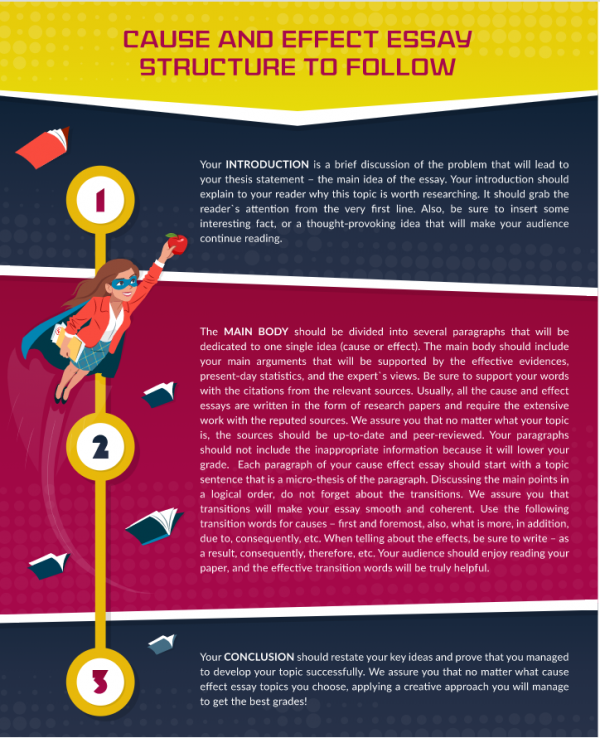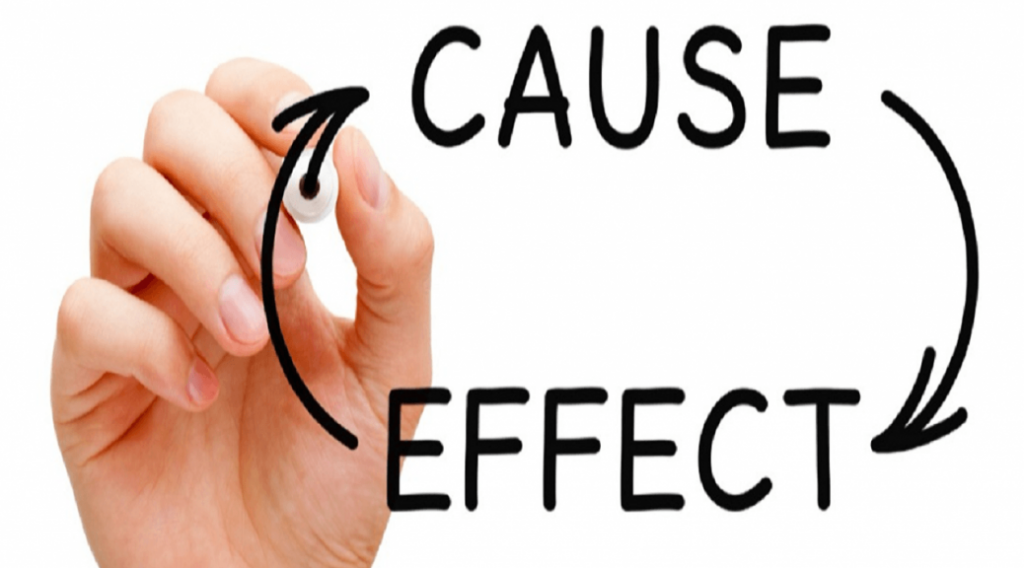Cause and effect essays help students explore the reasons behind events and the consequences they create. Whether you’re analyzing personal choices, social behaviors, or major global trends, this essay format encourages deeper thinking and structured writing. It’s a useful skill for both academic and real-life analysis. If you’re struggling with essay structure or need expert help, consider our essay writing service for professional support. In this guide, we’ll walk you through the basics of cause and effect writing and provide over 100 fresh topic ideas to inspire your next assignment.
What is a Cause and Effect Essay?
A cause and effect essay is a type of academic writing that explains why something happens (the cause) and what happens as a result (the effect). It’s a useful format for examining real-world issues, personal choices, or historical events by looking at their root causes and outcomes. Instead of just stating facts, this essay helps you explore deeper connections between events and build logical reasoning.
These essays are common in school and college because they help students develop critical thinking and analytical skills. Whether you’re exploring the effects of climate change or the reasons behind teenage anxiety, this style encourages structured, thoughtful writing. If you’re new to this format, our complete essay structure guide breaks down how to organize your ideas step by step.
How to Choose a Good Cause and Effect Topic?
Picking the right cause and effect topic is key to writing an impactful essay. A great topic not only keeps you engaged but also gives you enough material to explore both the causes and the resulting effects. Here are some practical tips to help you choose the perfect one:
- Start with what interests you: Choose a topic you’re curious about — whether it’s related to health, technology, education, or social issues. When you’re personally interested, researching and writing becomes a lot more enjoyable.
- Look for a clear connection: A strong cause and effect topic should clearly show how one event leads to another. Avoid vague ideas. For instance, instead of “Social media,” try “How social media use affects teenage mental health.”
- Check relevance and timeliness: Trending or timely topics (like climate change or remote learning) often make stronger essays. They’re more engaging and offer lots of updated research material online.
- Make sure it’s research-friendly: Before finalizing your topic, do a quick search to see if there’s enough credible information available. A great idea means nothing if you can’t back it up with solid facts and examples.
- Narrow your focus: Avoid broad topics like “Pollution” or “Technology.” Instead, focus on a specific angle like “The effect of single-use plastics on marine life” or “How AI is changing job opportunities.”
- Know your audience: Think about who will read your essay. Are you writing for a professor, a general audience, or fellow students? Tailor your topic to fit their level of understanding and interest.
- Avoid overused topics: Topics like smoking or global warming are widely used. If you pick one, be sure to bring a fresh perspective — maybe by connecting it to a local issue or a personal story.
- Brainstorm with purpose: Still stuck? Create a list of causes or effects first, then see how they can connect. You can even use mind-mapping tools to visually organize your ideas before selecting the final topic.

100+ Cause and Effect Essay Topics for Students
Below are rich, original ideas across seven categories—each one crafted to spark cause‑and‑effect analysis and avoid overused prompts.
General Cause and Effect Essay Topics
- How a lack of planning causes project delays
- The effect of consistent reading on vocabulary growth
- How multitasking lowers productivity in everyday tasks
- Effects of regular goal setting on personal success
- The influence of early life habits on adult routines
- How excessive noise impacts concentration and mood
- Effects of frequent travel on personal relationships
- How seasonal changes affect daily motivation
- The consequences of over-scheduling leisure time
- How kindness leads to better social experiences
- The ripple effect of small financial decisions over time
- How cultural events shape public behavior and traditions
- Effects of social comparison on self-esteem
- How music genres influence emotional responses
- The impact of long commutes on daily stress levels
Education & Student Life Topics
- How school uniforms affect student behavior
- Effects of teacher enthusiasm on classroom engagement
- How online learning changes academic discipline
- The impact of early school start times on focus
- How peer tutoring improves academic performance
- Effects of over-involvement in extracurriculars on grades
- The link between student housing and exam performance
- How parental pressure influences career choices
- The effect of learning environments on retention
- How study groups enhance or hurt learning
- Impact of part-time jobs on academic life
- The cause of test anxiety and its effects on results
- How leadership roles in school affect self-confidence
- The effect of teacher feedback on student progress
- How school holidays influence learning momentum
Technology & Digital Life Topics
- How smartphone addiction affects sleep quality
- Effects of screen time on children’s attention spans
- How AI tools change traditional job roles
- The impact of social media filters on self-image
- How online shopping habits affect budgeting skills
- The consequences of sharing personal data online
- How algorithmic bias influences user decisions
- The effect of constant notifications on productivity
- How video conferencing affects team dynamics
- Effects of tech dependency on critical thinking
- How online reviews influence consumer behavior
- The cause of digital burnout in remote workers
- How gaming communities affect social interaction
- Effects of trending challenges on teen behavior
- How wearable devices promote healthier lifestyles
Health & Wellness Topics
- How daily water intake affects energy levels
- The link between stress and skin conditions
- How dietary choices impact sleep quality
- Effects of sugar consumption on concentration
- How poor posture leads to chronic back pain
- The mental health effects of long-term isolation
- How meditation reduces anxiety symptoms
- Effects of gym culture on body image
- How skipping breakfast affects metabolism
- How walking daily benefits cardiovascular health
- Effects of overtraining on athletic performance
- How caffeine impacts teenage sleep cycles
- The link between gut health and mood swings
- How noise pollution affects mental well-being
- Effects of journaling on emotional regulation
Environment & Climate Topics
- How carpooling reduces carbon footprints
- Effects of climate change on global food security
- How plastic bans impact local economies
- The link between urban heat islands and health risks
- How rising sea levels affect coastal communities
- Effects of drought on agriculture and food prices
- How deforestation leads to increased wildfires
- The consequences of noise pollution on wildlife
- How single-use plastics harm marine life
- Effects of green spaces on urban well-being
- How eco-tourism affects local ecosystems
- Impact of oil spills on ocean biodiversity
- How global warming alters migration patterns
- How electric vehicles influence energy demand
- Effects of industrial farming on soil health
Family & Relationships Topics
- How sibling rivalry shapes personality traits
- Effects of divorce on adolescent behavior
- How digital communication affects emotional intimacy
- The impact of birth order on family roles
- How family meals influence communication patterns
- Effects of parental support on teen confidence
- How cultural differences affect relationship expectations
- The role of pets in family bonding
- How childhood trauma influences adult relationships
- Effects of financial stress on romantic partnerships
- How social media use changes family dynamics
- The impact of long-distance relationships on trust
- How grandparent involvement affects child development
- How technology use before bed affects relationships
- Effects of neglecting quality time with loved ones
Economy & Work Trend Topics
- How inflation affects household spending behavior
- Effects of remote jobs on urban population trends
- How gig work reshapes traditional job markets
- The consequences of underemployment on well-being
- How entrepreneurship boosts local economies
- The impact of student debt on financial independence
- How job insecurity leads to increased anxiety
- Effects of automation on career planning
- How workplace flexibility improves productivity
- How tax incentives influence business growth
- Effects of wage gaps on workforce morale
- How side hustles affect work–life balance
- The effect of workplace diversity on innovation
- How unpaid internships impact career development
- How company culture influences employee retention
Cause and Effect Essay Writing Tips
Writing a cause and effect essay is all about showing the connection between two things — how one situation or action leads to another. Whether you’re exploring small personal habits or major social issues, the key is to explain why something happens and what comes next. Here are some helpful tips to make your essay stand out:
Choose a Focused Topic
Pick a subject with a clear cause-and-effect link. Avoid topics that are too broad or too vague. The clearer the connection, the easier it is to write a strong essay.
Craft a Strong Thesis Statement
Your thesis should clearly define the cause and the effect you’ll explore. It sets the tone for your entire essay and keeps your writing focused.
Use a Logical Structure
Organize your essay in a way that makes sense — either:
- Chronologically (in order of events),
- By importance (from most to least significant), or
- Categorically (grouping similar causes or effects together).
Start With an Outline
Planning your structure in advance helps keep your ideas organized. It’s a great way to ensure your essay has a logical flow from start to finish.
Write a Clear Introduction
Begin with some background info on the topic, then present your thesis statement to show what you’ll be analyzing.
Build Strong Body Paragraphs
Each paragraph should focus on one specific cause or effect. Use examples, research, or personal experience to support your ideas. Keep the discussion clear and to the point.
Use Transitions
Guide your readers with smooth transition words like “as a result,” “because,” “due to,” or “therefore.” These help connect your ideas clearly and logically.
Avoid Overused Phrases
Be original in how you express your points. Avoid clichés or generic statements. Your writing should feel fresh and insightful.
Stay Clear and Concise
Use simple language and short sentences. Don’t overload your essay with unnecessary details that may confuse your readers.
Add Credible Sources (If Needed)
If your topic involves data or real-world trends, support your claims with reliable sources. This adds depth and credibility to your writing.
Conclude Effectively
Wrap up your essay by summarizing your key points and restating the main cause-and-effect relationship. Don’t introduce new ideas in the conclusion.
Edit and Revise
Always revise your draft. Look out for grammar mistakes, unclear points, or weak arguments. A clean, polished essay always performs better.
Keep It Objective
Present your ideas fairly and clearly. Even if you’re passionate about a topic, try to remain unbiased and back your points with facts.
Proofread Before Submitting
Finally, double-check for typos, punctuation errors, and formatting issues. A well-proofread essay looks more professional and earns higher marks.
Conclusion
Cause and effect essays help you understand the “why” behind events and actions — from small daily decisions to major global issues. By choosing a strong topic and organizing your thoughts clearly, you can write essays that are both insightful and impactful. Whether you’re exploring social issues, education, technology, or personal experiences, this essay format helps sharpen your critical thinking and writing skills.
If you ever feel overwhelmed or need expert help, the team at Peachy Essay is here to support your academic journey with custom writing, editing, and guidance.
Frequently Asked Questions
What is a cause and effect essay?
A cause and effect essay explains how one event (the cause) leads to another (the effect). It’s designed to show the relationship between actions, situations, or ideas, helping readers understand the reasons something happened and what resulted from it.
How do I choose a good topic for a cause and effect essay?
Pick a topic that has a clear relationship between cause and effect. Make sure it’s something you can research and explain easily. Real-life issues, current events, or personal experiences often make the best essay topics.
What is the ideal structure for a cause and effect essay?
Most essays follow this simple structure:
- Introduction with a thesis
- Body paragraphs (each explaining a cause or effect)
- Conclusion that summarizes key points
Make sure each section flows logically and sticks to the main idea.
How many causes or effects should I include?
That depends on your essay length and topic. For a short essay, focus on one cause and one effect. For longer papers, you can include multiple causes or effects, but make sure each one supports your thesis and stays relevant.
Can I write about personal experiences?
Yes, especially if your topic is relatable or reflective. Personal stories can add a unique touch and help readers connect with your content — just make sure to keep it focused on the cause and effect relationship.


